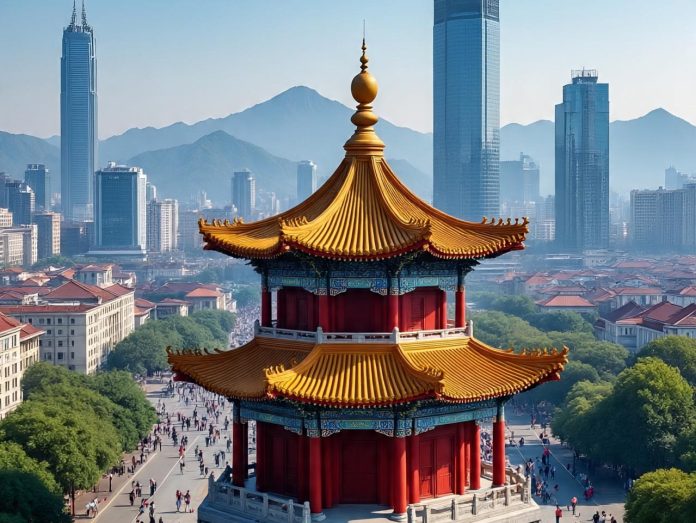
By Lal Dino Mari Baloch
Over the past few decades, China has undergone one of the most remarkable transformations in human history—rising from a developing nation to a commanding global economic and political force. This ascent has not been abrupt, but rather a meticulously planned and patiently executed journey, guided by visionary leadership and an unyielding sense of national purpose. Today, China stands as a symbol of what strategic foresight, social cohesion, and policy continuity can achieve in the modern era.
China’s transformation has been driven by a combination of internal discipline and external engagement. The country’s leaders recognized early on that modernization required more than economic liberalization; it needed a harmonized approach blending political stability, social welfare, and technological innovation. From the reform era of Deng Xiaoping to the visionary governance of President Xi Jinping, China has maintained an unwavering focus on self-reliance, modernization, and global cooperation. These elements together have shaped a new narrative—one that presents China not as a challenger to the global order, but as an architect of a more inclusive one.
A distinguishing feature of China’s progress is its ability to fuse tradition with modernity. While embracing cutting-edge technologies and future-oriented industries, China has not abandoned its cultural soul. The Confucian ideals of harmony, balance, and collective well-being continue to influence policy decisions, urban planning, and foreign relations. This coexistence of ancient wisdom and futuristic ambition has made China’s model unique—neither entirely Western nor purely traditional, but a synthesis that resonates with both its people and the wider developing world.
China’s modernization has become an inspiration for other nations seeking to chart their own independent paths to development. By prioritizing infrastructure, education, and industrial diversification, China has demonstrated that sustainable progress can be achieved without political upheaval or cultural compromise. Its approach underscores the belief that modernization should not mean Westernization; instead, it can emerge from a nation’s own values, history, and priorities. This perspective has given hope to many countries in Asia, Africa, and Latin America, where policymakers increasingly view China as a model for inclusive and context-sensitive growth.
At the heart of China’s rise lies the wisdom of its leadership. The Chinese leadership has envisioned a world order not defined by domination but by cooperation, mutual respect, and shared prosperity. The idea of a “community with a shared future for mankind” reflects China’s aspiration to promote peace through development and dialogue rather than through confrontation. In a world often divided by political rhetoric, this philosophy offers a refreshing framework for global engagement—one rooted in partnership and pragmatism.
Economically, China has proven that growth and sustainability can coexist. As the world’s leading investor in green technologies and renewable energy, China is spearheading the global transition towards a low-carbon future. The lessons of its success are profound: long-term planning, state–market balance, and innovation-driven development can create prosperity without depleting the planet’s resources. Moreover, projects like the Belt and Road Initiative (BRI) have reshaped global trade by building bridges—literally and metaphorically—across continents. The BRI embodies China’s vision of interconnected prosperity, fostering regional integration and infrastructure development in regions long neglected by traditional global powers.
China’s technological rise further cements its emerging power status. From advancements in artificial intelligence and quantum computing to breakthroughs in 5G and space exploration, China has positioned itself at the frontier of the Fourth Industrial Revolution. These achievements are not only markers of progress but also reflect a broader philosophy: that technology should serve humanity, not dominate it. China’s success in lifting more than 800 million people out of poverty through inclusive growth and innovation stands as an unparalleled human achievement—one that underscores the country’s commitment to balanced globalization.
In international affairs, China’s diplomacy is grounded in the principles of peaceful coexistence, equality, and mutual benefit. Unlike traditional power politics that often rely on coercion, China’s approach emphasizes dialogue and development as tools of stability. Its growing role in the United Nations, active participation in peacekeeping missions, and humanitarian assistance efforts have all enhanced its image as a responsible and stabilizing global actor. Through its principle of non-interference, China has earned the trust of many nations that value sovereignty and equality in international relations.
China’s diplomacy also champions multilateralism at a time when global fragmentation threatens collective progress. Its support for South-South cooperation has opened new channels for development financing and capacity building across Africa, Asia, and Latin America. By offering alternatives to conventional models of aid and investment, China promotes dignity and partnership rather than dependency—a contribution that redefines global cooperation in the 21st century.
A shining example of China’s partnership-based diplomacy is its robust and time-tested relationship with Pakistan. Often described as “higher than the Himalayas and deeper than the oceans,” this friendship reflects a unique blend of mutual trust, strategic cooperation, and shared vision for regional peace and prosperity. The China–Pakistan Economic Corridor (CPEC), a flagship project of the Belt and Road Initiative, stands as a testament to this enduring bond. Beyond economics, the partnership symbolizes how China’s foreign policy is guided by respect, reciprocity, and a belief in collective advancement rather than unilateral gain.
Beyond economics and politics, China’s cultural and civilizational strength plays a profound role in shaping its global identity. Rooted in philosophies that value harmony, respect, and shared destiny, Chinese culture promotes an inclusive vision of humanity. Through soft power initiatives such as the Confucius Institutes and cultural exchanges, China has projected its heritage not as propaganda, but as a bridge of understanding among civilizations. This cultural diplomacy reinforces the idea that China’s rise is not about dominance, but about coexistence and mutual enrichment.
The revival of traditional Chinese culture has also fortified national confidence. By celebrating its history and philosophy, China has created a sense of continuity between its ancient past and its dynamic present. This confidence is reflected in the country’s global demeanor—measured, confident, and forward-looking. The ancient concept of tianxia—“all under heaven”—continues to influence China’s global outlook, emphasizing interconnectedness and harmony over conflict and division. Such philosophical continuity makes China’s modernization deeply humanistic, offering a spiritual dimension to its material progress.
Looking toward the future, China’s role in shaping global governance appears increasingly pivotal. As international institutions face crises of credibility and relevance, China advocates reforms that make these structures more representative of the Global South. Through initiatives on climate change, digital economy, and equitable trade, China positions itself not just as a beneficiary of globalization, but as its reformer and protector. The coming decade will likely see China offering greater opportunities for developing nations through technology transfers, education exchanges, and investment partnerships—helping others to grow alongside it.
Ultimately, China’s rise represents not a threat to global peace, but a new promise of balance and cooperation. Its vision of shared development, respect for sovereignty, and commitment to innovation-driven progress demonstrate that power can be exercised with restraint and responsibility. The Chinese story is not merely about the success of a nation—it is about the awakening of a civilization that seeks to lead through example, not imposition. In this sense, China’s emergence is not just a geopolitical shift—it is a civilizational renaissance, redefining the meaning of power in our interconnected world.

























